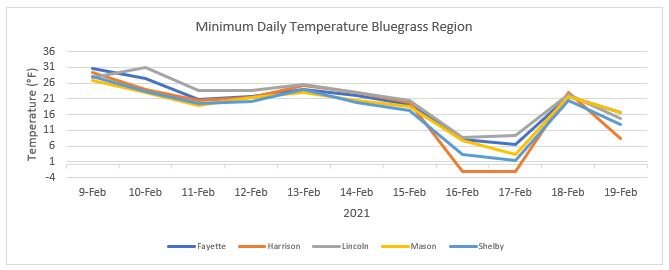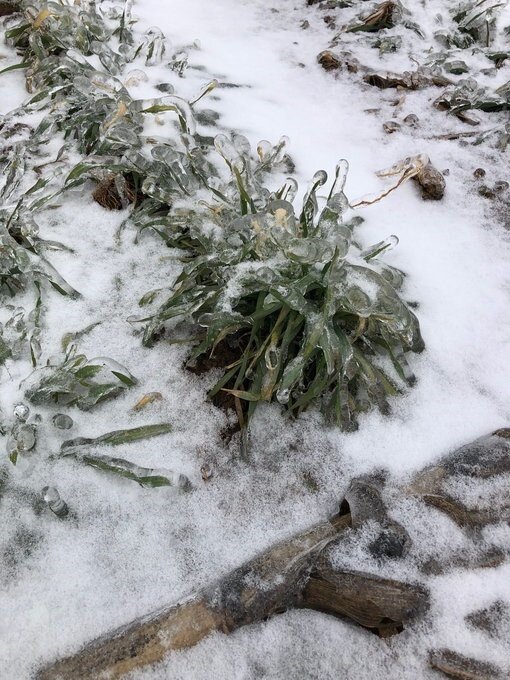Scouting for Wheat and Small Grains Condition following Bitter Cold Temperatures
Carrie Knott, Grain Crops Extension Agronomist-Princeton
To say that we have had a cold and snowy 10 days would be an understatement! Since Feb 9 a large portion of the state has had ice, snow, more ice, and more snow, all with bitterly cold temperatures that are truly unheard of in Kentucky. Not to mention that all this happened during a La Niña winter that was predicted to be warmer than average!
Since about Feb 11, the high temperatures across the state have been and remained below freezing (Figure 1). In addition, the low temperatures have been bitterly cold with single digit and even negative values recorded across the entire state, which is particularly unusual for the Purchase and Midwestern regions of the state (Figure 2).
Figure 1. Daily maximum temperatures for many of the wheat producing regions, by county, in Kentucky. Data obtained from the KyMesonet (https://www.kymesonet.org/).
Figure 2. Daily minimum temperatures for many of the wheat producing regions, by county, in Kentucky. Data obtained from the KyMesonet (https://www.kymesonet.org/).
Fortunately for our wheat and small grains crops, there is a layer of ice (Figure 3) and several inches of snow that has insulated the crop from these bitterly cold temperatures. Both should provide enough protection that freeze damage is not expected. However, it is likely a good plan to go ahead and scout for any potential freeze injury or damage as soon as temperatures warm up.
Figure 3. Layer of ice and some snow on cereal rye at Spindletop Research Farm, Lexington. Photo: Dave VanSanford.
Currently, the extended forecast for most of the state is calling for high temperatures to be greater than 40°F beginning Feb 21. Given that we need about 5 to 7 days of active growth, high temperatures ≥40°F, we should be able to scout for any damage by about Saturday Feb 27 at the earliest. Likely there will be cosmetic damage to leaf or leaf tips, which will include yellowing and for certain varieties, particularly cereal rye, purpling (Figure 4). There is little concern about this damage. The damage that would be of concern is if you can smell a ‘silage’ odor coming from the fields, if the entire fields appear ‘blue’ in color, or if the stems of the plants have lost their firmness and definition and feel ‘mushy’. Again, this damage is unlikely given that we had an insulating ice/snow cover. But it is worth a trip to the field to identify if damage occurred so that you can plan for the most profitable course forward for 2021.
For additional information on identifying freeze damage in winter wheat, which can be used for all small grains, refer to Identifying Damage and Estimating Yield Reductions following a Spring Freeze in Winter Wheat.
Figure 4. Cosmetic yellowing of leaves and leaf tips that is characteristic of freeze damage at early growth stages. This damage does not impact final grain yield as long as stems remain firm and undamaged.







